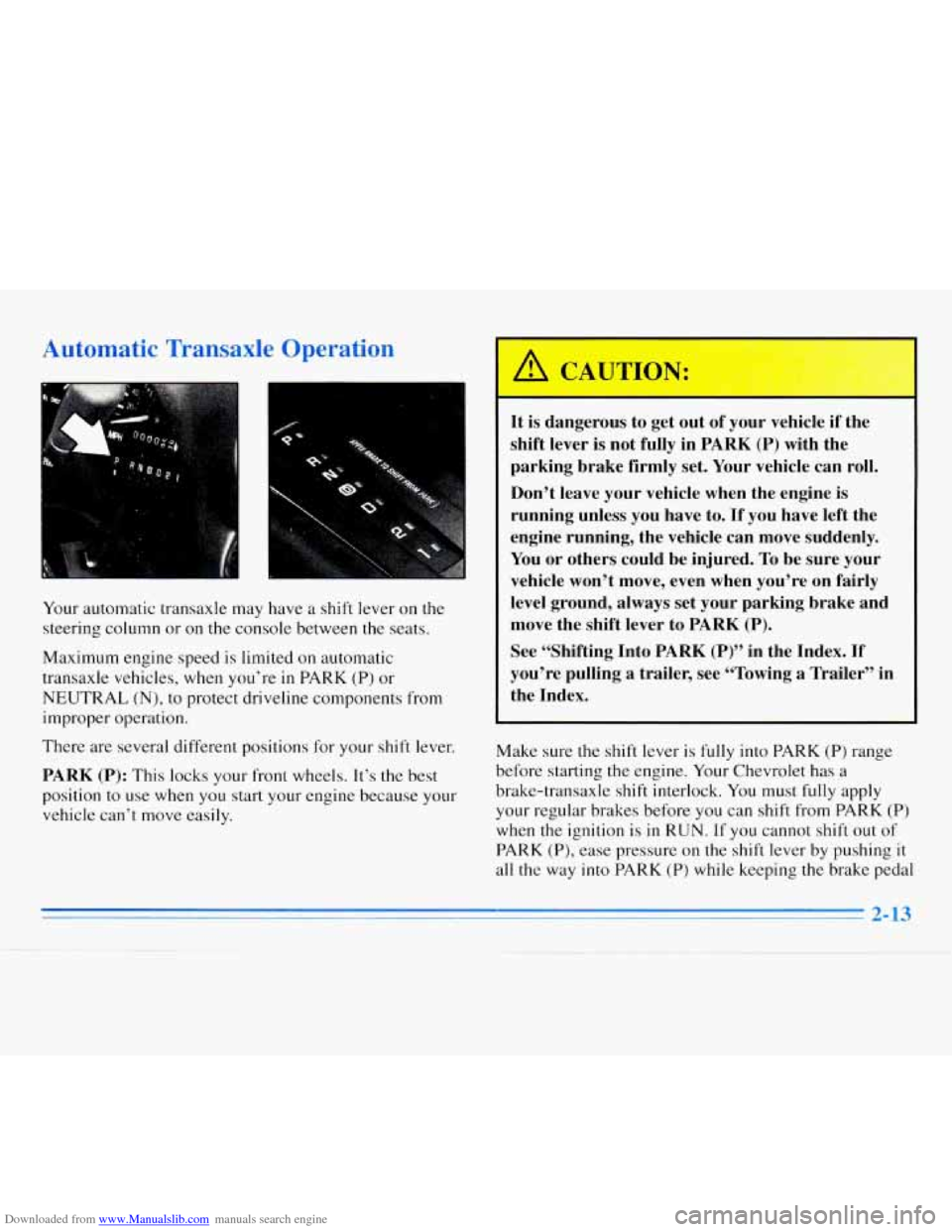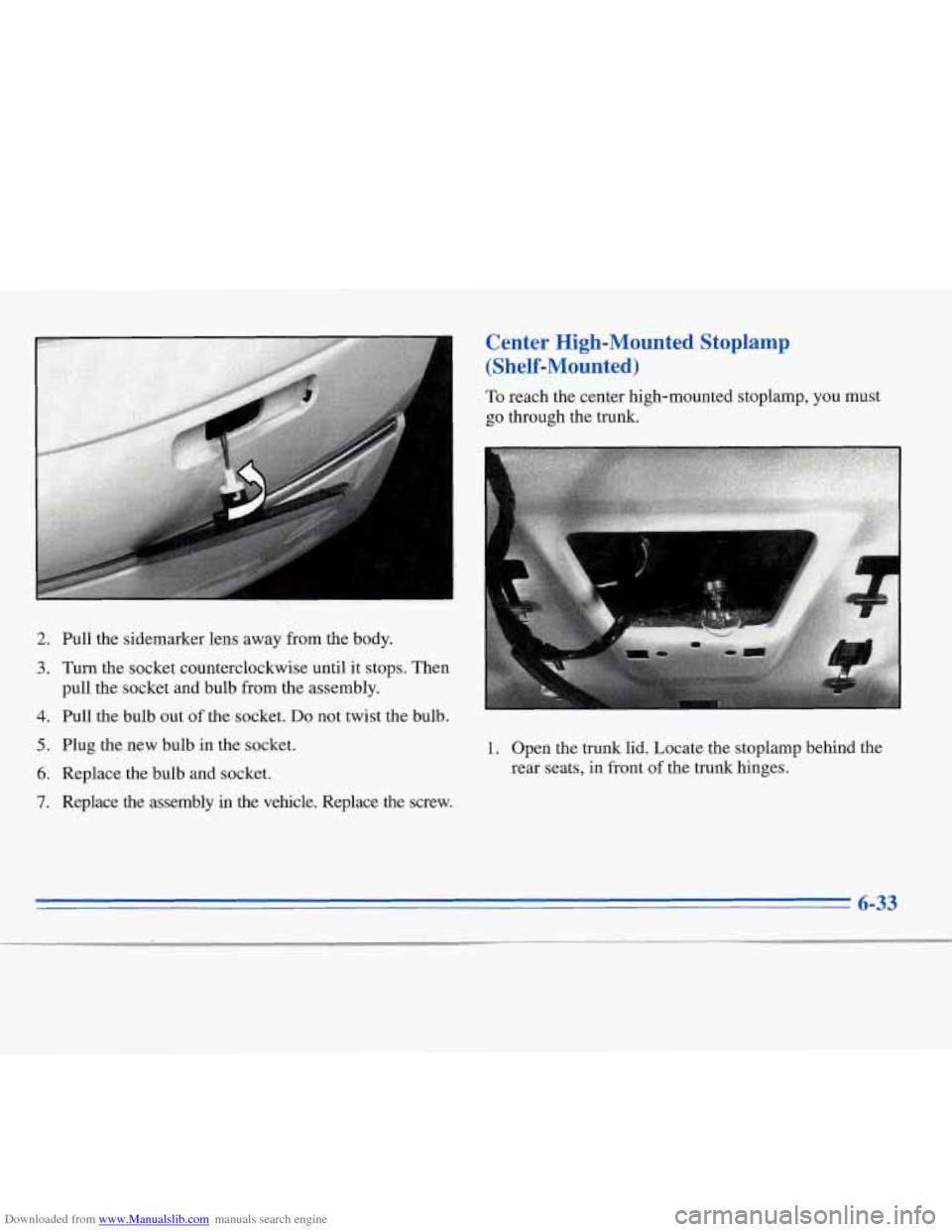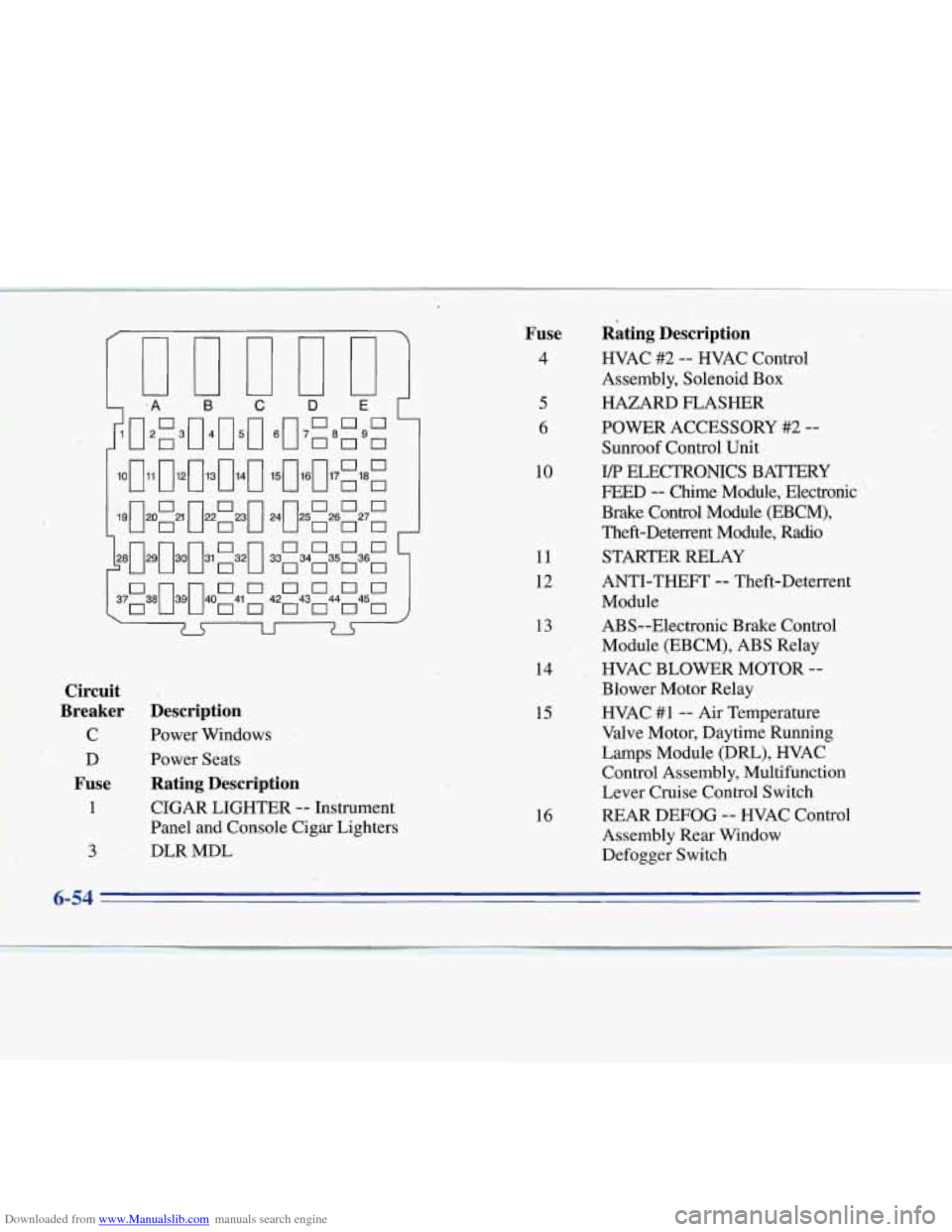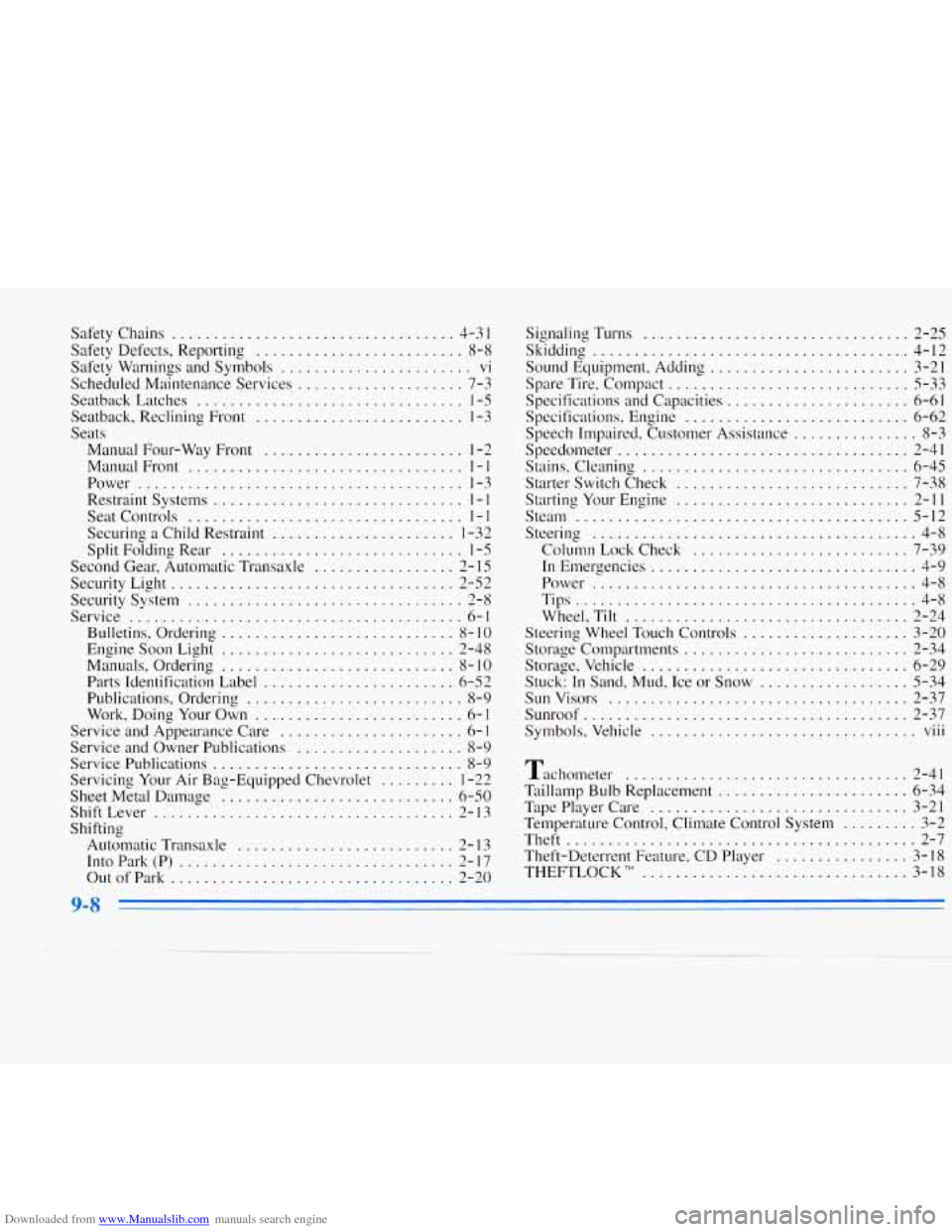seats CHEVROLET MONTE CARLO 1996 5.G Owners Manual
[x] Cancel search | Manufacturer: CHEVROLET, Model Year: 1996, Model line: MONTE CARLO, Model: CHEVROLET MONTE CARLO 1996 5.GPages: 340, PDF Size: 17.79 MB
Page 3 of 340

Downloaded from www.Manualslib.com manuals search engine d> The 1996 Chevrolet Monte Carlo Owner’s Manual
Seats and Restraint Systems ............................................................. 1-1
Features and Controls
.................................................................. 2-1
Comfort Controls and Audio Systems
..................................................... 3-1
This section tells you how to use your seats and safety belts properly. It also explains the air bag system.
This section explains how
to start and operate your Chevrolet.
This section tells
you how to adjust the ventilation and comfort controls and how lo operate your
audio system.
Here
you’ll find helpful information and tips about the road and how to drive under different conditions.
This section tells you what
to do if you have a problem while driving, such as a tlat tire or overheated
engine, etc.
Here
the manual tells you how to keep your Chevrolet running properly and looking good.
This section tells you when
to perform vehicle maintenance and what fluids and lubricants to use.
This section tells you how
to contact Chevrolet for assistance and how to get service and owner publications.
It also gives you information on “Reporting Safety Defects” on page 8-8.
Index ........................................................................\
........ 9-1
Here‘s an alphabetical listing of almost every subject in this manual. You can use it to quickly find
something you want to read.
YourDrivingandtheRoad .............................................................. 4-1
ProblemsontheRoad .................................................................. 5-1
ServiceandAppearanceCare ............................................................ 6-1
Maintenanceschedule
.................................................................. 7-1
Customer Assistance Information
........................................................ 8-1
i
Page 13 of 340

Downloaded from www.Manualslib.com manuals search engine 0 Section 1 Seats and Restraint Systems
Here you'll find information about the seats in your Chevrolet and how to use your safety belts properly.
You can also learn about some things you should not
do with air bags and safety belts.
Seats and Seat Controls
This section tells you how to adjust the seats and explains
reclining seatbacks, folding rear seats and head restraints.
You can lose control of the vehicle if you try to
adjust a manual driver's seat while the vehicle is
moving. The. sudden movement could startle and
confuse you, or make you push
a pedal when you
don't want to. Adjust the driver's seat only when
the vehicle is not moving.
Lift the bar under the front of the seat to unlock it. Slide
the seat to where you want it and release the bar.
Try to
move the seat with your body to be sure the seat is
locked
in place.
i 1-1
Page 23 of 340

Downloaded from www.Manualslib.com manuals search engine How to Wear Safety Belts Properly
Adults
This part is only for people of adult size.
Be aware that there are special things to know about safety
belts and children. And there are different rules for smaller
children and babies.
If a child will be riding in your
Chevrolet, see the part
of this manual called “Children.”
Follow those rules for everyone’s protection.
First, you’ll want to know which restraint systems your
vehicle has.
We’ll start with the driver position.
Driver Position
This part describes the driver’s restraint system.
Lap-Shoulder Belt
The driver has a lap-shoulder belt. Here’s how to wear
it properly.
1. Close and lock the door.
2. Adjust the seat (to see how, see “Seats” in the Index)
so you can sit up straight.
3. Pick up the latch plate and pull the belt across you.
Don’t
let it get twisted.
The shoulder belt may lock
if you pull the belt across
you very quickly.
if this happens, let the belt go back
slightly
to unlock it. Then pull the belt across you
more slowly.
Page 51 of 340

Downloaded from www.Manualslib.com manuals search engine You‘ll be using the lap-shoulder belt. See the earlier part
about the top strap
if the child restraint has one.
1.
2.
3.
4.
Because your vehicle has a right front passenger air
bag, always move the seat as far back as
it will go
before securing a forward-facing child restraint.
(See “Seats” in the Index.)
Put
the restraint on the seat. Follow the instructions
for the child restraint.
Secure the child
in the child restraint as the
instructions say.
Pick up the latch plate, and run the lap and shoulder
portions of the vehicle’s safety belt through or
around the restraint. The child restraint instructions
will show you how.
If the shoulder belt goes
in front of the child‘s face or
neck, put
it behind the child restraint. 5. Buckle the belt. Make sure the release button is
positioned
so you would be able to unbuckle the
safety belt quickly
if you ever had to.
Page 71 of 340

Downloaded from www.Manualslib.com manuals search engine Automatic Transaxle Operation
-I
Your automatic transaxle may have a shift lever on the
steering column or on the console between the seats.
Maximum engine speed
is limited on automatic
transaxle vehicles, when you’re
in PARK (P) or
NEUTRAL (N), to protect driveline components from
improper operation.
There are several different positions for your shift lever.
PARK (P): This locks your front wheels. It’s the best
position to use when
you start your engine because your
vehicle can’t move easily.
It is dangerous to get out of your vehicle if the
shift lever
is not fully in PARK (P) with the
parking brake firmly set. Your vehicle can
roll.
Don’t leave your vehicle when the engine is
running unless you have to.
‘If you have left the
engine running, the vehicle can move suddenly.
You
or others could be injured. To be sure your
vehicle won’t move, even when you’re on fairly
level ground, always set your parking brake and
move the shift lever to
PARK (P).
See (‘Shifting Into PARK (P)” in the Index. If
you’re pulling a trailer, see “Towing a Trailer” in
the Index.
Make sure the shift lever is fully into PARK (P) range
before starting the engine. Your Chevrolet has
a
brake-transaxle shift interlock. You must fully apply
your regular brakes before you can shift from PARK (P)
when the ignition is
in RUN. If you cannot shift out of
PARK (P), ease pressure on the shift lever by pushing it
all the way into PARK (P) while keeping the brake pedal
- 2-13
Page 116 of 340

Downloaded from www.Manualslib.com manuals search engine 0
0
0
0
ilation Ti-
For mild outside temperatures when little heating or
cooling is needed, use
VENT to direct outside air
through your vehicle.
Keep the hood and front air inlet free of ice, snow or
any other obstruction, such
as leaves. The heater and
defroster will work far better, reducing the chance of
fogging the inside of your windows.
When you enter
a vehicle in cold weather, set the
mode to FLOOR and the fan to the highest speed for
a few moments before driving off. This helps clear
the intake ducts of snow and moisture and reduces
the chance of fogging the inside
of your windows.
Keep the air path under the front seats clear of objects.
This helps
air to circulate throughout your vehicle.
Defogging and Defrosting
Your system has two settings for clearing the front and
side windows.
To defrost the windows quickly, use
DEFROST with
the temperature knob(s) all the way in
the red area. To warm passengers while keeping the
windows clean, use DEFOG.
Rear Window Defogger
The rear window defogger
uses a warming grid to
remove fog
from the rear
window. Press the button to
turn the defogger on.
I
It will turn itself off after about ten minutes. If you turn
it on again, the defogger will only run for about five
minutes before turning off. You can also turn
it off by
turning
off the ignition or pressing the button again.
Do not attach anything like a temporary vehicle license
or decal across the defogger grid.
3-4
Page 164 of 340

Downloaded from www.Manualslib.com manuals search engine I ! CAUTION:
Things you put inside your vehicle can strike and
injure people in a sudden stop or turn, or in
a crash.
0
0
0
0
0
Put things in the trunk of your vehicle. In a
trunk, put them as far forward as you can.
Try to spread the weight evenly.
Never stack heavier things, like suitcases,
inside the vehicle
so that some of them are
above the tops of the seats.
Don’t leave an unsecured child restraint in
your vehicle.
When you carry something inside the
vehicle, secure
it whenever you can.
Don’t leave a seat folded down unless you
need to.
If you don’t use the correct,equipment and drive
properly, you can lose control when you pull a
trailer. For example,
if the trailer is too heavy, the
brakes may not‘work well
-- or even at all. You
and your passengers could be seriously injured.
Pull a trailer only
if you have followed all the
steps in this section. Ask your Chevrolet dealer
for advice and information about towing a trailer
with your vehicle.
NOTICE:
Pulling a trailer improperly can damage your
vehicle and result in costly repairs not ,covered
by
your warranty. To pull a trailer correctly, follow
the advice in this part, and see your Chevrolet
dealer for important information about towing a
trailer
with your vehicle.
Page 241 of 340

Downloaded from www.Manualslib.com manuals search engine 2.
3.
4.
5.
6.
7.
Pull the sidemarker lens away from the body.
Turn the socket counterclockwise until it stops. Then
pull the socket and bulb from the assembly.
Center High-Mounted Stoplamp
(Shelf-Mounted)
To reach the center high-mounted stoplamp, you must
go through the
trunk.
I Pull the bulb out of the socket. Do not twist the bulb.
Plug the new bulb in the socket.
Replace the bulb and socket.
Replace the assembly in the vehicle. Replace the screw.
1. Open the trunk lid. Locate the stoplamp behind the
rear seats, in front of the tmnk hinges.
Page 262 of 340

Downloaded from www.Manualslib.com manuals search engine [,) -A B C D E
Circuit .
Breaker Description
C Power Windows
D Power Seats
Fuse Rating Description
1 CIGAR LIGHTER -- Instrument
Panel and Console Cigar Lighters
3. DLRMDL
5
6
10
11
12 13
14
15
Fuse Rating Description
4 HVAC #2 -- WAC Control
Assembly, Solenoid Box
HAZAP
FLASHER
Sunroof Control Unit
I/P ELECTRONICS BATTERY
FEED -- Chime Module, Electronic "
Brake Control Module (EBCM),
Theft-Deterrent Module, Radio
STARTER RELAY
ANTI-THEFT
-- Theft-Deterrent
Module
ABS--Electronic Brake Control
Module (EBCM), ABS Relay
Blower Motor Relay WAC
#1 -- Air Temperature
Valve Motor, Daytime Running
Lamps Module
@RL), HVAC
Control Assembly, Multifunction
Lever Cruise Control Switch
16 REAR DEFOG
-- HVAC Control
Assembly Rear Window
Defogger Switch
POWER ACCESSORY
#2 --
, WAC
BLOWER MOTOR --
6-54
Page 336 of 340

Downloaded from www.Manualslib.com manuals search engine Safety Chains .................................. 4-3 I
Safety Defects. Reporting ......................... 8-8
Safety Warnings and Symbols
....................... vi
Scheduled Maintenance Services .................... 7-3
SeatbackLatches
................................ 1-5
Seatback. Reclining Front ......................... 1-3
Seats
Manual Four-Way Front
........................ 1-2
ManualFront
................................. 1-1
Power ....................................... 1-3
Restraint Systems .............................. 1 - 1
Seat Controls ................................. I - 1
Securing a Child Restraint ...................... 1-32
Split Folding Rear
............................. 1-5
Second Gear. Automatic Transaxle
................. 2- 15
Security Light
.................................. 2-52
Service
........................................ 6-1
Bulletins. Ordering
............................ 8- 10
EngineSoonLight ............................ 2-48
Manuals. Ordering
............................ 8- 10
Parts Identification Label ....................... 6-52
Publications. Ordering
.......................... 8-9
Work. Doing Your
Own ......................... 6-1
Service and Appearance Care ...................... 6- 1
Service and Owner Publications .................... 8-9
Service Publications
.............................. 8-9
Servicing
Your Air Bag-Equipped Chevrolet ......... 1-22
Sheet Metal Damage
............................ 6-50
ShiftLever
.................................... 2-13
Shifting
Automatic Transaxle
.......................... 2- 13
Into Park (P)
................................. 2-17
OutofPark
.................................. 2-20
Security System
................................. 2-8
Signaling Turns
................................ 2-25
Skidding
...................................... 4-12
Sound Equipment. Adding
........................ 3-21
Spare Tire. Compact
............................. 5-33
Specifications and Capacities
...................... 6-61
Specifications. Engine
........................... 6-62
Speech Impaired. Customer Assistance
............... 8-3
Speedometer
................................... 2-41
Stains. Cleaning
................................ 6-45
Starter Switch Check
............................ 7-38
Starting Your Engine
............................ 2-11
Steam ........................................ 5-12
Steering ....................................... 4-8
Column Lock Check
.......................... 7-39
In Emergencies
................................ 4-9
Power
....................................... 4-8
Tips
......................................... 4-8
Wheel. Tilt
.................................. 2-24
Steering Wheel Touch Controls
.................... 3-20
Storage. Vehicle
................................ 6-29
Stuck:
In Sand. Mud. Ice or Snow .................. 5-34
Sunvisors
.................................... 2-37
Sunroof
....................................... 2-37
Symbols
. Vehicle ................................ v111
Storage Compartments ........................... 2-34
...
Tachometer .................................. 2-41
Taillamp Bulb Replacement
....................... 6-34
TapePlayerCare
............................... 3-21
Temperature Control. Climate Control System
......... 3-2
Theft
.......................................... 2-7
Theft-Deterrent Feature. CD Player
................ 3-18
THEFTLOCK”
................................ 3-18
9-8